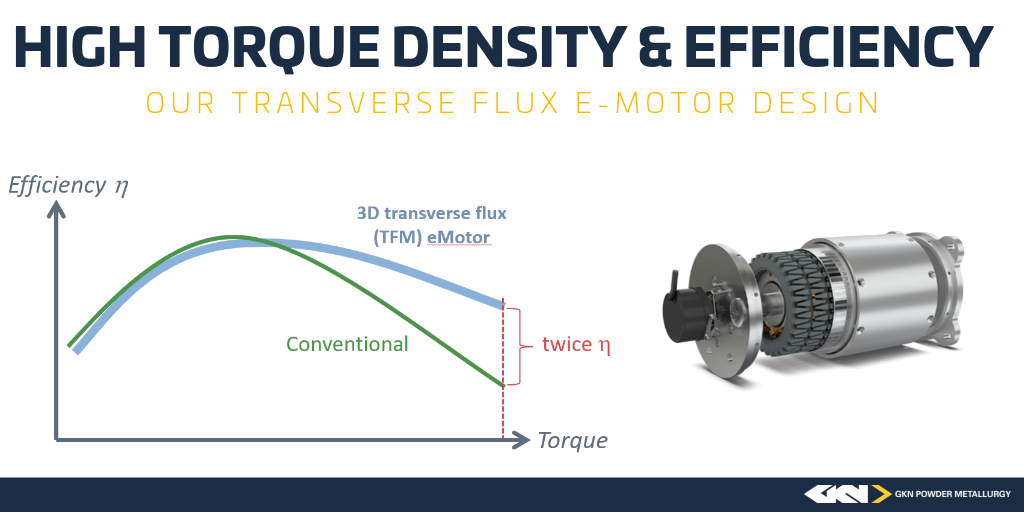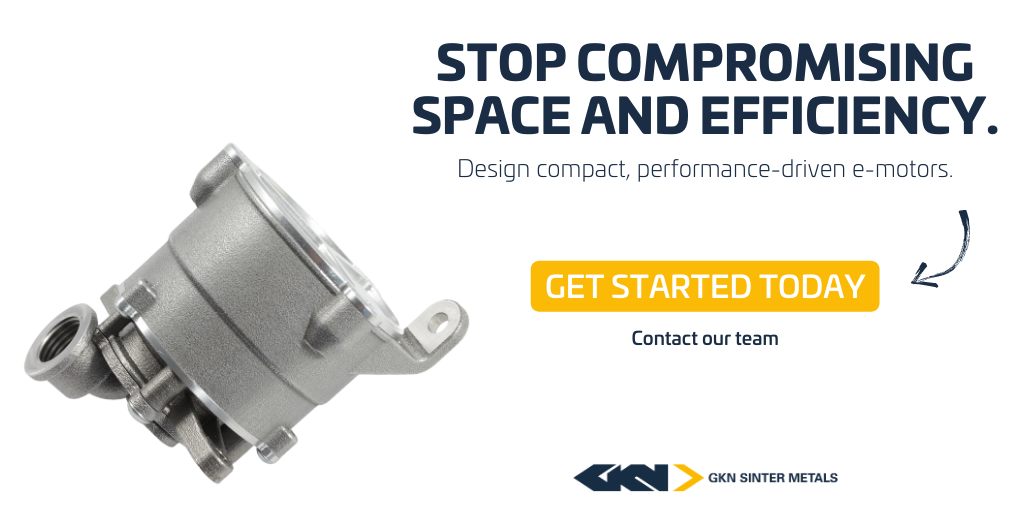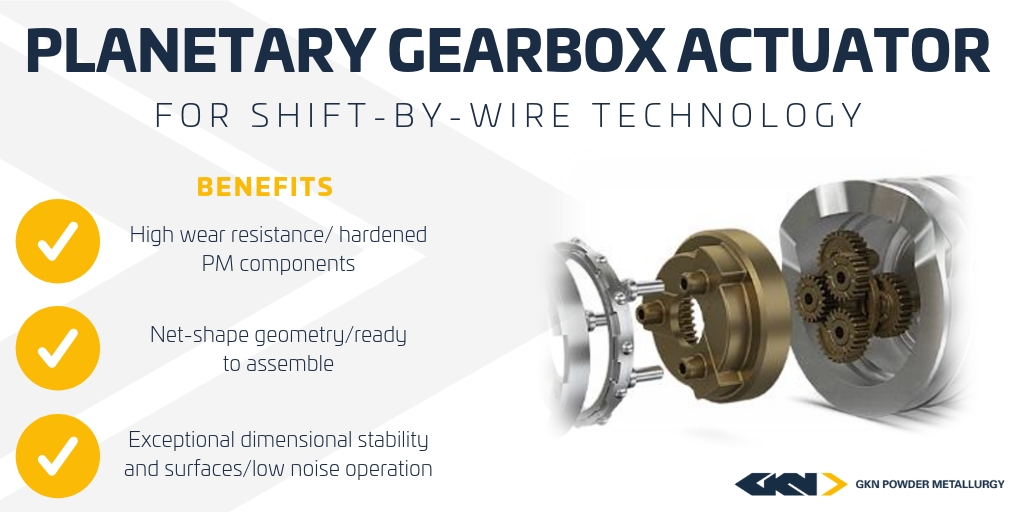Read time: 3 mins
Date posted: Jul 2019
Theme: Electrification, Product Innovations
Q&A: How to validate powder metallurgy's role in electric vehicles
Light, small, strong and efficient: these are the parameters by-wire application solutions require for hybrid and fully electric powertrains.
The added pressures of emission reductions and new technology at a competitive cost create a challenge for automotive engineers in the next wave of electrified application development.
How can a partnership with a powder metal supplier support automotive electrification application development?
I posed this question to Stefan Tiller, who leads the advanced PM technology group for vehicle electrification at GKN Powder Metallurgy to discuss PM's role in vehicle electrification.
Sometimes powder metallurgy is perceived as a heavy and slow process. How could the technology turn this narrative by supporting vehicle electrification on a large scale?
Unfortunately, there are still some that have a prejudice about powder metallurgy technology. But when we work together with engineers who are open to the technology's capabilities, they are really excited about the advanced product solutions that we can provide in PM.
PM allows for endless material compositions that are not feasible to do in traditional wrought steels. In electrified applications, magnetically active materials with very specific physical requirements are needed for functionality reasons. This is where we can offer a wide range of customizations by designing material characteristics around specific application requirements.
So, is powder metallurgy is a competitive technology for large scale production? Definitely. Actually, there are many proven application examples established in the market where powder metallurgy is the best choice! Small gears, sliding bearings and especially structural components are known for their unique functional and economical advantages.
Could you provide more concrete examples of PM in applications for hybrid electric vehicles (HEVs) and fully electric vehicles (EVs)?
You'll find powder metal components in electromagnetic applications like linear actuators, e-drive traction motors and electric pumps. For these applications, specific magnetic material characteristics are key. Our soft magnetic sintered and non-sintered iron types (we call soft magnetic composites SMCs) are the perfect fit.
Another important area of application in the electrification trend of vehicles are by-wire applications. Steer-by wire, shift-by-wire and brake-by-wire applications have benefited from sintered components for years with cost effective solutions. I still remember in 2006, when we started to deliver the first pair of belt pulleys in powder metal for an electrically assisted EPS steering system. Since then, this steer-by-wire application has spread from luxury vehicle classes to mid and even small class cars.
How are powder metal suppliers preparing for electrification? Explore the strategy here.
I would also like to mention the break-by-wire application, where sintered components play a key role. Think about when you are parking your car. For around a decade, this functionality is performed by electric parking brakes. And as an add-on functionality, the assisted hill-start offers additional safety and comfort. In both cases, the driver just pushes a button and the brake is electrically activated or released. In recent cars, emergency braking is activated when collision objects are detected by several types of sensors or integrated radar systems. This is only feasible with the brake-by-wire technology.
What is the exact role of PM in a brake-by-wire system?
PM technology transforms the electric signal into an actuation force at the brake discs through a powerful and lightweight mechanical actuator. The heart of this actuator is a small planetary gearbox set with high strength gears and toothed carriers; all made out of powder metal components. This technology is responsible for converting the rotational movement of an electric motor into a lower speed ratio and into an axial clamping force that secures or opens the rear wheel discs.
The same happens when you are switching gears by the paddle shifters on the side of your car's steering wheel. In this case, the hardware job of shifting the transmission gear inside the hybrid transmission is done by a planetary gearbox actuator produced out of hardened and annealed powder metal components. This technology is known as shift-by-wire.
You have mentioned that SMCs are used for electric motor applications. What is the magic behind SMCs?
SMC material is based on pure iron powder where each particle is covered with a very thin isolation layer. It is called a 3D isotropic material and is crucial for reducing the eddy current losses in electrical systems.
This material allows for specific stator designs of e-motors creating a unique 3D-magnetic flux. That offers enormous advantages for the e-motor size, design integration capabilities and enables highest torque and power densities.
Learn more about the powder of SMCs in e-motors here.
E-motors of this class are called axial flux (AFM) or transverse flux (TFM) motor types, also called e-motor topologies.
Let's put in perspective how powerful and effective SMC e-motors can be. Recently it was announced that Ferrari's new plug-in-hybrid car model Stradale F90 uses the YASA e-motor. This high-performance AFM type motor uses a double disc rotor and stator technology, which is made with SMC poles.
Quite astonishing! It's obvious that electric AFMs and TFMs are not widely known. Why would you recommend that electrical design engineers consider researching this?
First of all, thanks for asking this and helping bring light to the use of SMC-powered e-motors!
While electrical engineers are happy with the electric efficiency and account for enough space for standard radial flux motors, I don't see a need to promote the use of AFM or TFM e-motor topologies.
Most of the current and future automotive or industrial applications require higher efficiency, smaller and lighter sizes. SMC based e-motor types comply with the highest expectations for power or torque density and overall efficiency. The assembly process is easier due to a less complex winding of the copper coils. This could also help reduce investment in winding equipment.

The AFM motor allows for space-saving, integrated designs and supports small assembly spaces for e-pumps.
We know that the latest design and simulation softwares for electric motor design are normally capable to consider AFM and TFM types. You can find electromagnetic values of our soft magnetic iron materials, sintered and non-sintered (SMC) on our website here:






